#set to wagner's ring cycle?
Explore tagged Tumblr posts
Text
Details:
1940s Hans Christian Andersen shorts: Intended as animated segments within a live-action film about the author's life, these would have adapted The Little Mermaid, The Fir Tree, Through the Picture Frame, The Emperor's Nightingale, and The Steadfast Tin Soldier. (Yes, I know we got adaptations of several of these, but I still want to share the concept art for old versions).
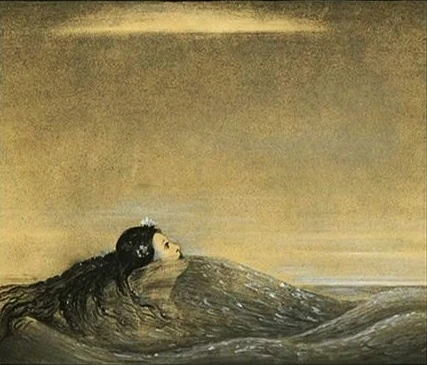
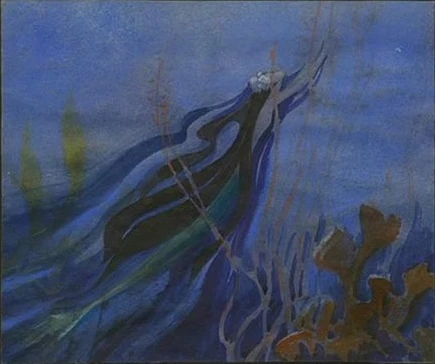
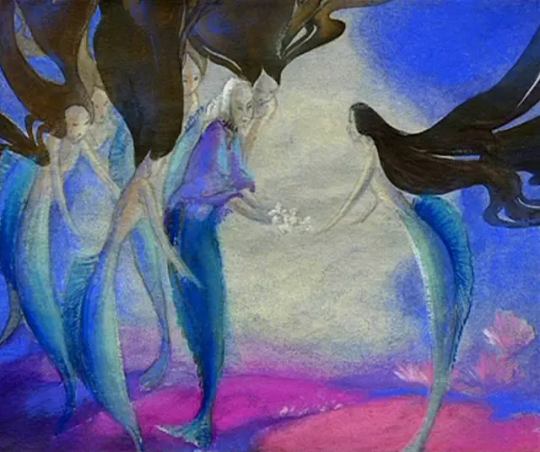

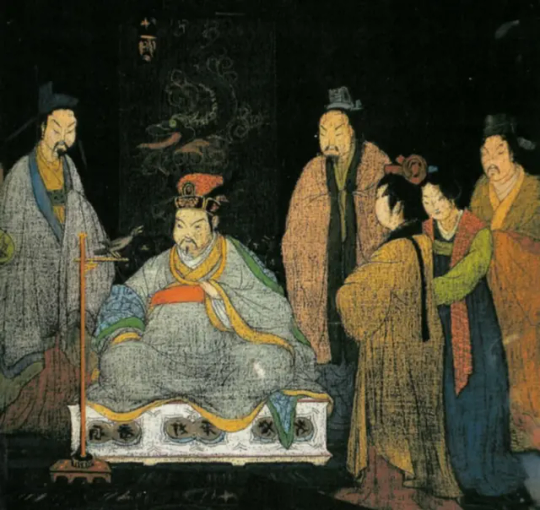

Gremlins: A film they worked on a lot during WWII but couldn't crack the story (or find money to make it)
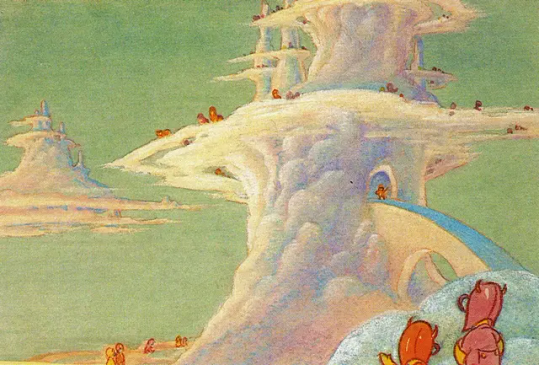


Don Quixote: They tried to adapt the story in various ways in the '40s, '50s, and '00s, which is too long to get into here, but it led to some interesting concept art.
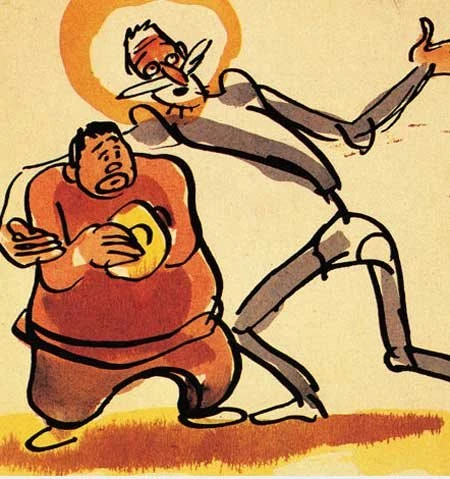
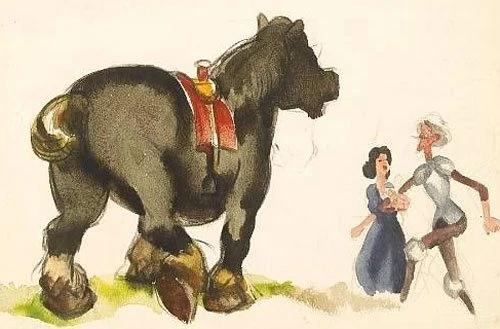
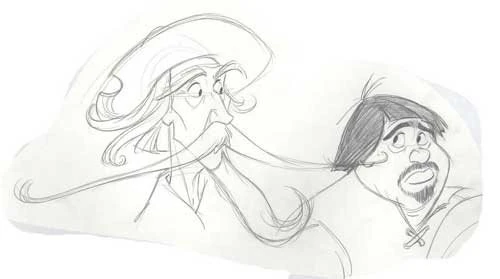
Chanticleer: A story about an arrogant rooster who thought his crow made the sun rise, and used this to rule over the other farmyard animals. Reynard the Fox was a villain who tried to take advantage of the discontent in the farm animals to take over as their leader (with plans to eat them), which leads to Chanticleer saving them and learning humility. Work started on it in the 1940s, and it was so close to being made in the 1960s, but they decided to go with The Sword in the Stone instead. Some of the animators loved it, though, and some of the character concepts were later adapted into Robin Hood.

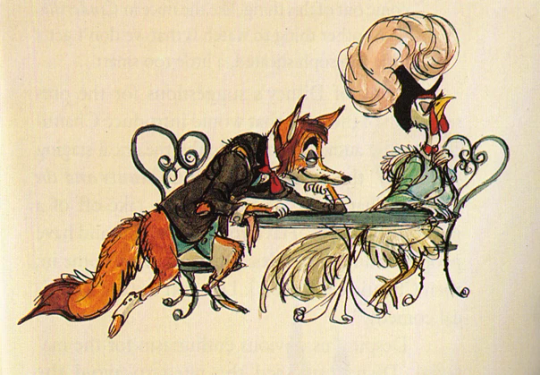
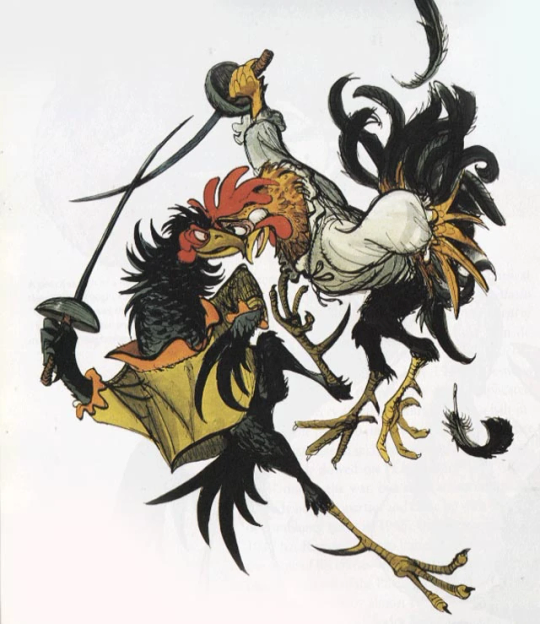
Catfish Bend: I haven't found much about the story beyond "talking animals in the South", but the concept art intrigues me. It would have been released in 1981, but after it was shelved, some of the concepts went on to inspire The Rescuers.
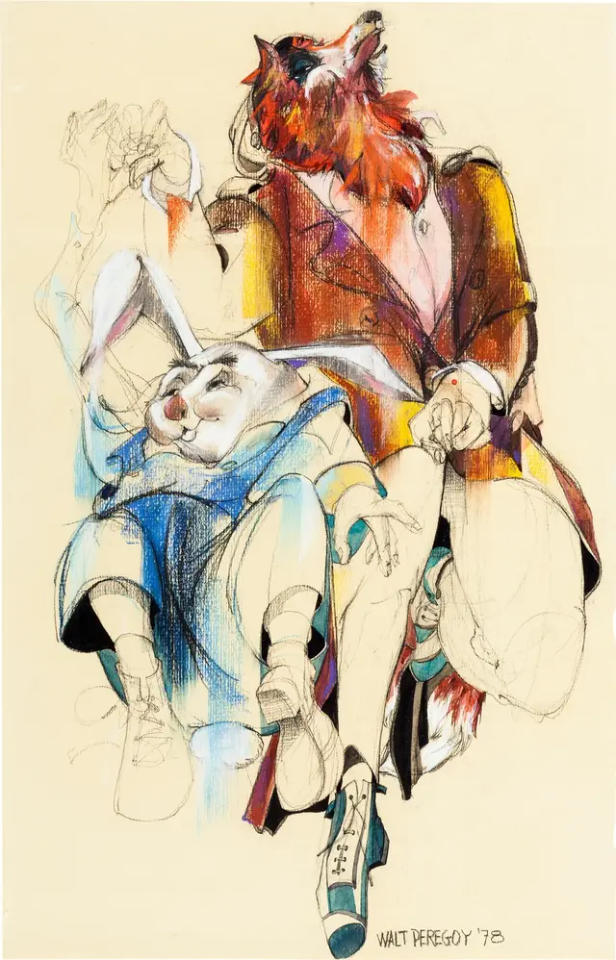

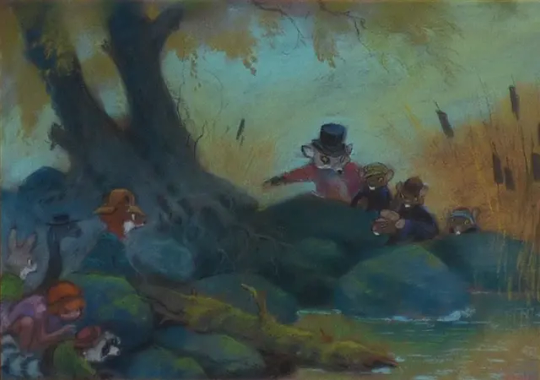
Mistress Masham's Repose: An adaptation of T.H. White's novel, pitched in the late 1980s
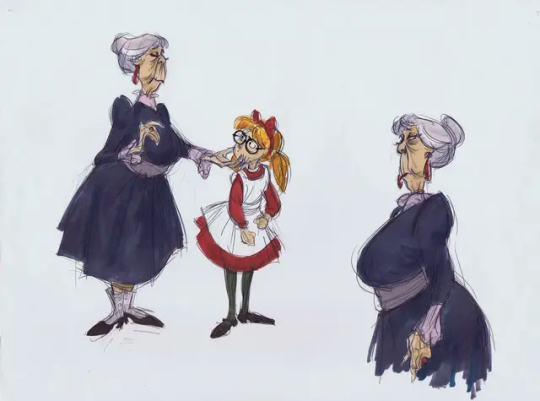
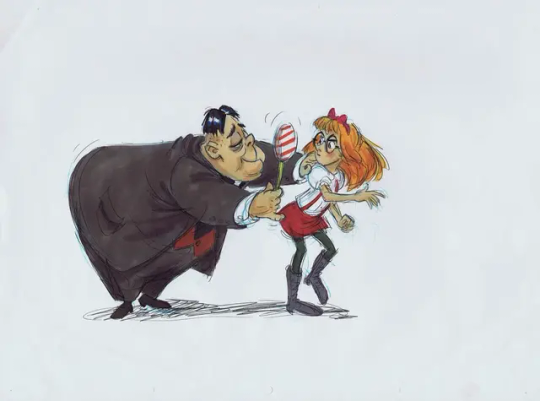
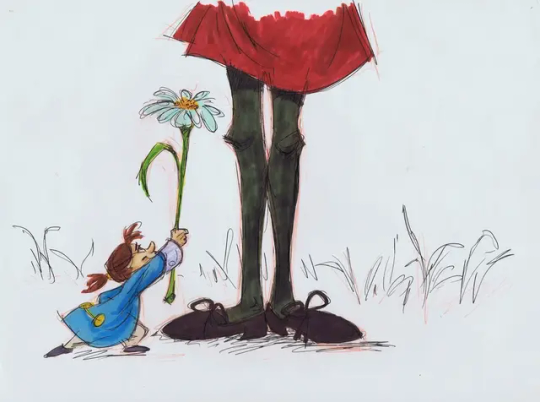
Fraidy Cat: 2009 film about a pampered housecat named Oscar who is falsely accused of kidnapping another pet and has to team up with a cockatoo and try to find the real culprit to clear his name. Shelved because they figured kids and general audiences wouldn't understand the Hitchcock references (which seems like a terrible reason, but alas).
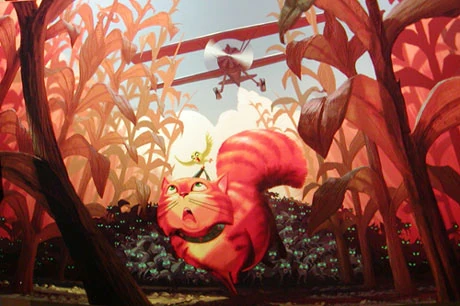
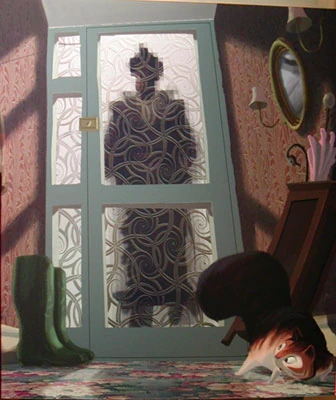
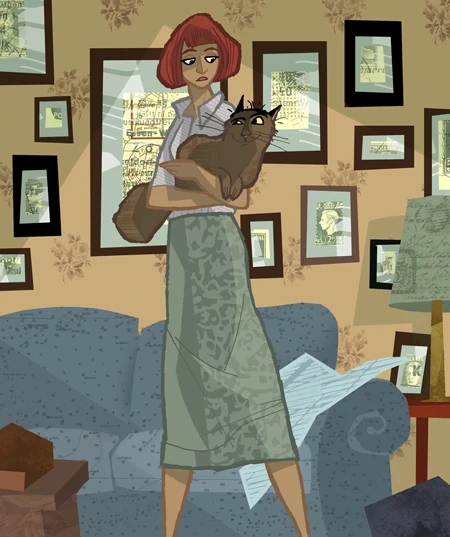
King of the Elves: Announced in 2009, it was a 3D animated film scheduled for 2012, before being shelved in 2016. Adapted from a Philip K. Dick story, it was about an ordinary man who saves some elves from a troll and (apparently reluctantly) gets declared their king.



Gigantic: A retelling of Jack and the Beanstalk set during the Spanish exploration, it involves Jack meeting an 11-year-old female giant who treats him like a doll, and eventually fighting much larger Storm Giants. Would have had songs written by the team from Frozen and was set to be released in 2018, then moved to 2020 before being cancelled because apparently they couldn't figure out the story.
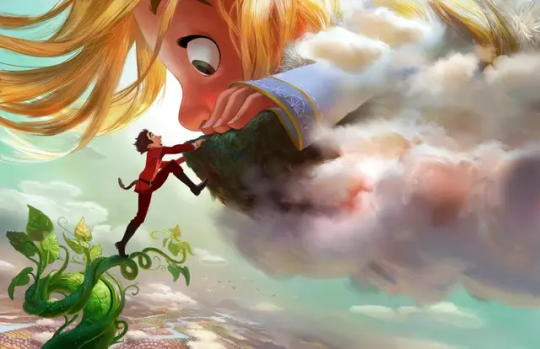


#polls#disney#random thought of the day#the dive down the rabbit hole forced me to make this#i tried to limit it to projects that weren't made later (except the hans christian andersen ones because kay nielsen did concept art!)#and to ones that had cool concept art available#and weren't sequels to other things#but there were a lot of cool ideas that didn't make it into the poll#did you know that someone pitched using elements of the hobbit in fantasia?#set to wagner's ring cycle?#(there were other disney tolkien pitches over the years but that one was one of the most intriguing)
84 notes
·
View notes
Text
Interesting post about costume here.
This paragraph in particular caught my attention...
What we think of as “peasant garb” is actually the product of a game of telephone that travels back from Romantic Revival art, and many of those (urban) artists got their idea of what rural peasants wore from opera costumes. The costumers working at the opera were not going out to the country side to take notes on what farmers actually wore, nor did they want to. Opera is show biz, you want it to be evocative, but not ordinary. Their costumes would have been based on what urban folks were wearing, with extra little touches like a shepherds crook to make it look “rural”.
... because it was Wagner's Ring Cycle that gave us horned helmets.
They didn't originate with the Vikings. They originated with the 1876 costume designs for a bunch of operas, and those designs by Carl Emil Doepler still exist.
For reference, all the horny characters are mortals.
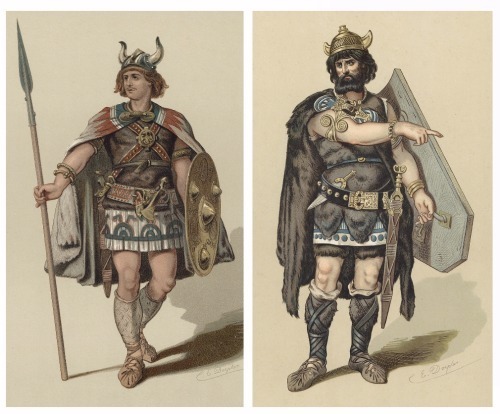

Those helmets were probably based on archaeological finds, even though all Northern European examples are, AFAIK and depending on context, either religious headgear equivalent to a bishop's mitre, or ceremonial headgear equivalent to a crown.
In addition, every single one predates the Viking Age by a period ranging from a couple of centuries to a couple of millennia so - makes vague handwave gesture - they're more appropriate for the sorta-kinda mythic Migration Era setting of the Ring than any Vik who ever inged..
Doepler's designs also feature WINGED helmets, worn by immortals like Wotan...
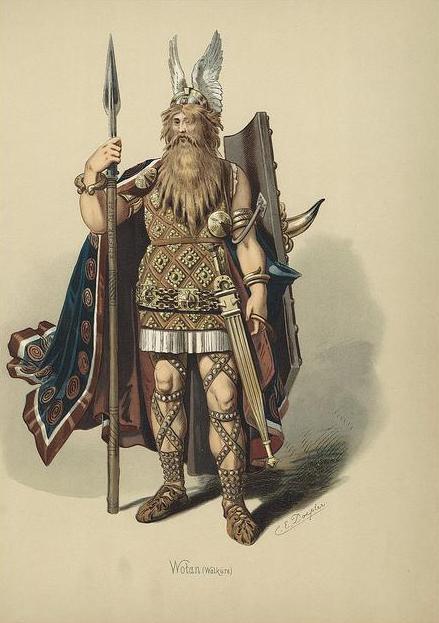
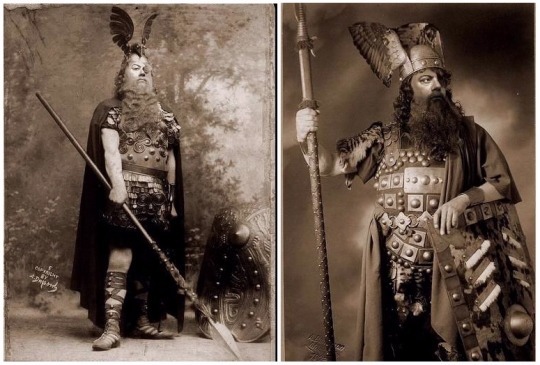
... and the Valkyries.
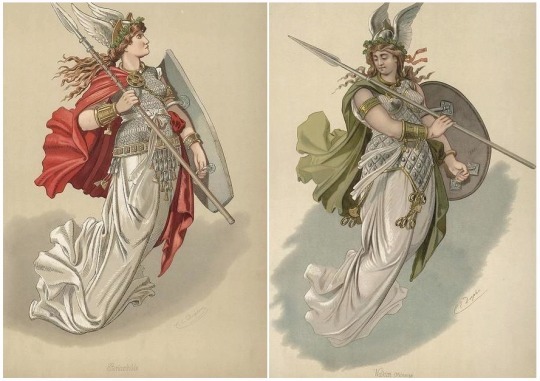


Something else I encountered when looking for pics to illustrate this was that other clichéd armour error, the boob-plate.
Here's dramatic soprano Karin Branzell wearing one...
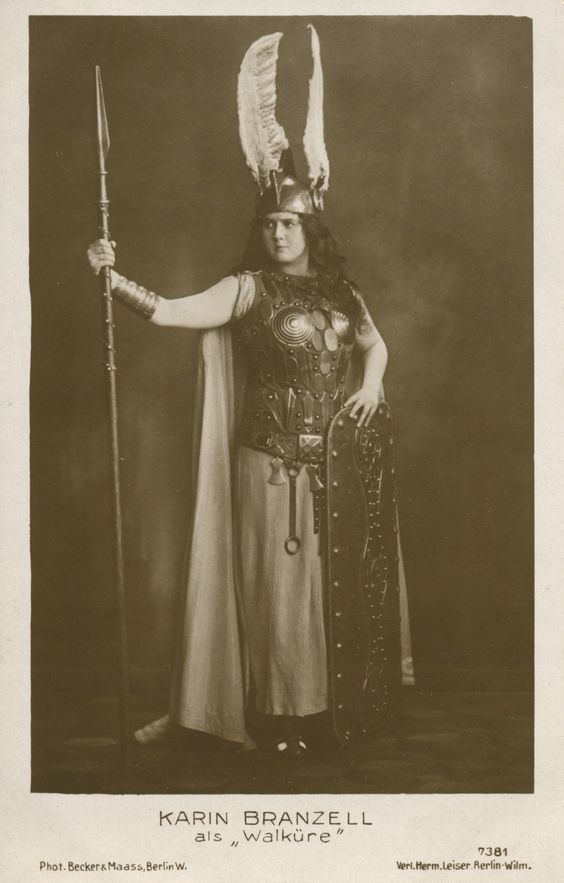
...while here's heroic tenor Fritz Vogelstrom also wearing one.
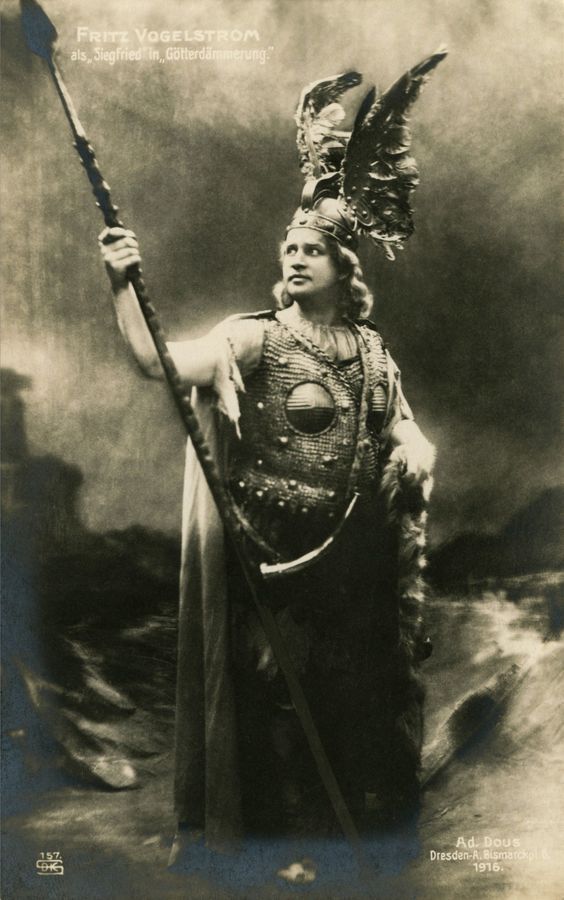
He's singing the role of Siegfried but wearing the costume of Brunnhilde, at least that's how it looks to an operatic Philistine like me.
Anyway...
Winged helmets are even more historically dodgy - no archaeological evidence at all - yet are actually more feasible as working combat helmets.
The difference is that horns, being heavy, need sturdy mountings so a horned helmet both provides catch-points for incoming blows and handles for an enemy to grapple, while a winged helmet does neither. The wings, being light, wouldn't need solid fixtures so would just shear off under a weapon or come off in an enemy's hands.
I'm well aware that other times, places and cultures - Indo-Persia, Poland, Japan etc. - had helmets with wings, horns and all sorts of other stuff, but this is about how the popular image of Vikings that headgear came from opera.
And went all over the place... :->
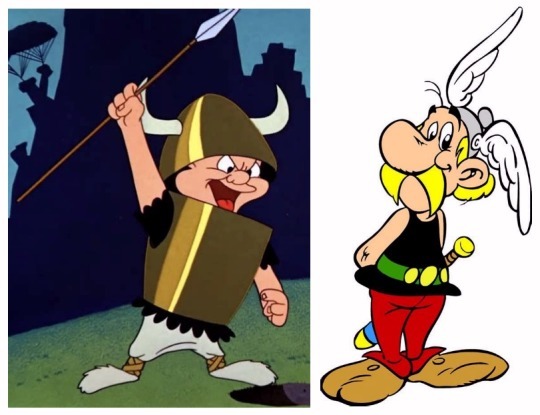


156 notes
·
View notes
Note
follow up to my previous ask:
do you have a specific performance of act iii that you think is best?
also throwing in that i am partial to Das Rheingold…any other 18th/19th century German (or otherwise) composers you recommend?
The Karajan recording with the Berliner Philharmoniker is my absolute favorite Ring Cycle. People call it the "chamber" version because it's a studio recording with a more intimate feel to it, and the interpretations and vocal cast are just fantastic. I have a particular affection for the soprano Gundala Janowitz (Sieglinde) and the unique tenor Gerhard Stolze (Loge/Mime).
As for other composers, you'd probably appreciate Bruckner, who was a dedicated Wagnerite. His Symphony No.4 (Romantic) is simply majestic and has one of my favorite finales of any symphony. He was also a devoted Catholic and composed a healthy collection of masses and choral settings.
youtube
The anti-modernist Hans Pfitzner composed an opera (he called it a Musical Legend) based loosely on Palestrina, and it follows the general formula of the late Wagnerian style (people like to meme on it by saying it's Parsifal without the laughs). As a drama, it is rather mediocre (the climax is at the end of the first act), but as a musical work I think it's incredibly enjoyable.
youtube
Mahler took the Wagnerian idiom and applied it to the symphony as well. His gargantuan Symphony No.2 (Resurrection) explores the challenges of the meaning of death and hope in everlasting life, and it strikes me as a work that you cannot listen to and walk away unchanged. (I've heard a running joke that while we might not know what Heaven looks like, if Mahler was even close then it's tuned to E-flat.) This recording is certainly not the best, but it's my favorite (movement timestamps in the comments).
youtube
And of course there's the Schubert, who I probably relate to most closely of any other composer. He has a sensitivity and intimacy that I think is hard to match, especially in his piano sonatas. The B-flat major continues to be my favorite. The work shifts harmonically all over the place, and it's a beautiful fusion of the late classical style with the romanticism of the 1800s.
youtube
I'll stop there or I'll end up listing all the hundreds of composers I regularly listen to from Bach to Pärt, but these are at least in the general periphery of Wagner.
9 notes
·
View notes
Note
(In the ask box because tumblr on phone dislikes me and will not show the lil note thing to reply on actual posts for Some Reason) I fuckin loved the Gondor/Rohan cultural influence thoughts if you do dish up more of the Thoughts I am so here for it
WOOFWOOFWOOF you’re enabling me. you’re enabling me!!!!! anyways screenshots from our DC dms bc I’m a lazy gremlin who cannot be bothered to re-type:


So this is like. this gets into a lot of half-formed thoughts abt other aspects of potential Rohirric culture and the overlap with iron-age Norse culture there which ties into the Gondorian overlap with fucking. Christians. WHICH IS ITS OWN CAN OF WORMS. but jts a can of worms were about to open
sorry if this is poorly formatted and rambly I’m sick and I don’t have the time off from work so there’s THAT and this feeds directly into my autistic special interests AND I’m a heathen so it also ties into my own religion :3
but when I was adding to the costuming document I made an offhand note about the fact Éowyn’s fashion most likely aligns more with Gondorian noble fashion than actual Rohirric fashion — bc the signifiers of nobility in iron-age Norse fashion came less from the type of garment but from the layers, dyes, and accessories. Éowyn, however, is dressed in a way which explicitly stands apart from the few common Rohirric women we see. so like.
Gondor as a homogenizing force.
I’m not going to use “colonizing” because Gondor never explicitly COLONIZED Rohan, but it very much has always positioned itself as Rohan’s better, and this holds true to Aragorn’s fucking coronation.
extrapolating from Norse culture, it seems Rohan was sort of the platonic ideal of the Germanic/Anglo-Saxon/Norse “viking.” Very Wagner’s Ring Cycle type of depiction, which gets into this weird romanticization while also depicting the gods especially as petty and self-centered, and denigrating the women. Turning from that, this fictionalized “ideal,” to what we know of the actual culture at that time— we get into a lot of grey areas. Was Rohan a raiding culture? quite possibly, at their start; I think it’s a fair assumption to make, that Rohan had a history of raiding. Which seems to have stopped once they settled in the land gifted to them by Gondor.
now, is raiding… good? oh gods no. absolutely not. but while there was a lot of violence typical of raids, not every expedition ended in raids— or was spent *only* on raiding. Vikings would stop and make camps, would trade, even settle in areas long enough that we have archaeological evidence of Danish jewelry made out of Frankish materials. Much of “viking” culture is built off borrowing; we have mjolnir pendants as modern heathens because these people saw Christian crosses, went “oh, that’s cool, we should have something to signify our faith!” and started forging mjolnirs. They were often produced by the same smiths! Sold in the same areas!
So, so much of this culture was decentralized. There was no set religious doctrine, histories and myths were told orally— hence why Skalds were so important (and likely why Théoden was so willing to take Gríma back despite. Everything). My hearth cult is different from your hearth cult is different from the hearth cults the next village over. Stories change with the times, names are lost and added, our culture shifts with the land and her people. The iron-age Norse peoples had very positive relations with Arab traders, to the point that we have an extremely detailed description of the funeral of (what was very likely) a nobleman documented by Ibn Fadlan; they had silks and glassware because of these trade relationships.
so you’ve got a culture built on adapting and borrowing, on *growing,* which has now 1) settled in one area and does not seem to send forces beyond their borders anymore, despite having a specialized category of “riders” not unlike the specialized category of “vikings” and 2) has a positive but distant relationship with its more powerful and decidedly centralized neighbor (not unlike norsemen with the English/French). aaaaaaaaand then there’s Thengel.
now like I said in DMs the blame very much does NOT rest on Thengel. like yea he kickstarted the process but I think this was very much inevitable. Gondor has written histories, better resources, like not even getting into the blood bullshit they just have a much more stable culture. Even if Christianity hadn’t done. what Christianity does. 😑 Norse peoples were worshipping Jesus alongside Þórr. it was simply a matter of time.
and like I stated above, the idea of Rohirrim as lesser and inherently violent is so pervasive even Faramir who is held up as the paragon of grace and nobility in the books does not BEGIN to question it. you don’t leave an environment where everyone thinks you’re lesser than them BY NATURE thinking “wow that was great, nothing about that needed to change!!” — I don’t blame Thengel in the slightest for going “yeah okay nobody in my line is EVER going to look stupid in front of another Gondorian.”
but at the same time as Westron and Sindarin are brought into the noble households, there doesn’t seem to be any similar push to preserve Rohirric oral traditions. Hell, considering the state of things by the war of the ring and the need for Riders, there’s a non-zero chance Gríma may have been the last “Skald” in Meduseld— which quite honestly explains even Éomer’s hesitance to explicitly harm him.
not to mention ultimately royal culture will bleed out into common culture— and eventually royal/noble culture will be all that survives. we have more place names for Þórr and Týr because they were worshipped more widely by the common folk, but more surviving NARRATIVES of Óðinn because he was worshipped by nobility and their closest warriors. If the noble culture of Rohan has shifted to more closely imitate Gondor, then it’s only a matter of time before all that’s left of actual Rohirric culture is place names and folk beliefs
like, I’m saying this as a heathen who’s doing his best to reconstruct a faith based off of archaeological evidence of my ancestors and one (1) surviving text that could be considered religious. EVERYTHING ELSE that is widely available is CHRISTIAN RETELLINGS. whose accuracy is EXTREMELY DEBATABLE. I don’t even necessarily prescribe to what many people consider one of the KEY myths!!!! and while there was a lot of violence involved in the spread of Christianity, quite clearly it does not need to start or end that way. specifically while the Norse peoples, it started very benignly as an interest in the symbols and holy figures— and turned into “all heathens are stupid dirty bloodthirsty monsters, their faith is cruel and backwards and only we Christians have any moral standing”
(Gondorians becoming more and more like those violent middlemen………)
it’s this very pervasive perspective that even when not backed with outright violence on Gondor’s point, clearly leads to the idea that to receive any sort of respect as Men, the Rohirrim must divest of anything that denotes they ARE Rohirric and live instead by Gondor’s standards— the only way to receive salvation is to follow Christ, et cetera et cetera et cetera. I got proselytized to with a bunch of friends in a fucking Mexican restaurant this shit still happens. she compared Christ to gravity and my faith as ridiculous and idiotic (as idiotic as denying that gravity exists).
and that’s part of why I like. don’t find the Gondorian perspective very compelling? like Boromir specifically is interesting because he explicitly defends Rohan and seems to carry a lot of like. both this openness to other cultures for the most part and this sort of trauma around a very similar pressure to Be A Proper Gondorian Heir, depending on how you want to read him— like this intense need to prove himself and his people as worthy to Aragorn, particularly in the films, is veeeeeeeerryyyyyy interesting to consider. meanwhile Denethor is Denethor and book!Faramir has his whole “taming” thing which I cannot even remotely stand. film!Faramir was thankfully spared the weird bullshit prejudices
it does also kind of inherently get into the question of how much of that attitude is specific to Minas Tirith; Gondor’s fucking massive, what pockets of cultures are surviving in coastal towns and out in the more distant regions? because there will always be bleeding, like I said, but this sort of Christian-adjacent attitude that is absolutely held by Gondorian nobility could very well be just that… a NOBLE attitude. the folk of western Anórien probably had WAY more in common with the neighboring Rohirrim on the Eastfold than ANYONE in Minas Tirith.
anyways, was this coherent? barely. do I care? no. I have a head cold. sources? a lot of the same creators as I cited for that gender in Rohan post that I’ll track down and link if the gods decide to bless me with a functional search bar on this site for ONCE, and Children of Ash and Elm. I also mentioned Wagner. I can’t in good faith recommend reading Wagner.
noble Gondorians sit down and shut up about Rohan challenge
(Gríma ramblings under the cut)


6 notes
·
View notes
Text
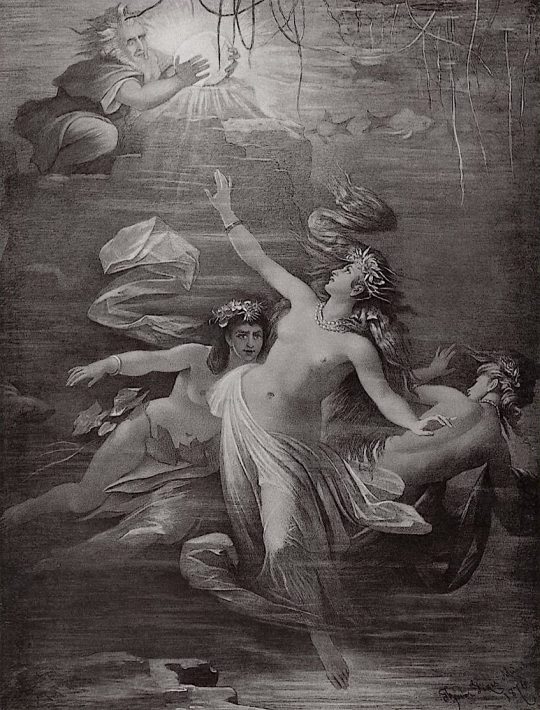
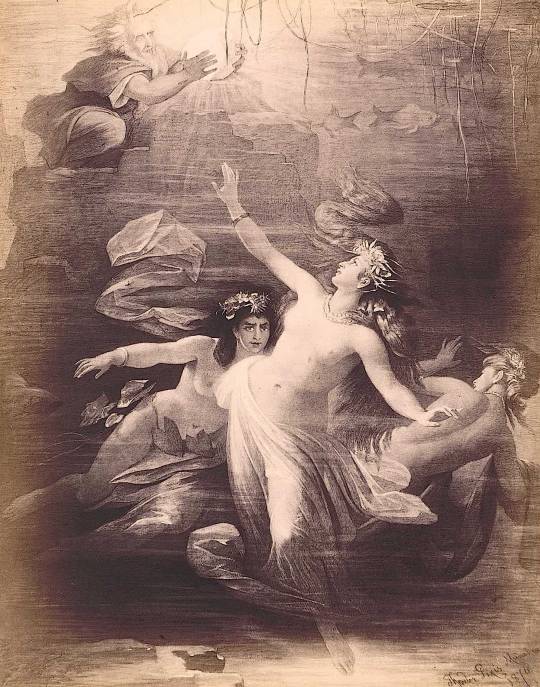
Robbery of the Rhinegold ~ 1876 ~ Theodor Pixis (German artist, 1831-1907) ~ Scene (Act 1) from the opera "The Rhinegold" - first of four music dramas from "The Ring of Nibelung" by Richard Wagner (German composer, 1813-1883)
"Das Rheingold" is set in a world of mythical giants and castles, magic potions and scheming dwarves, and the central toxic influence of the all-powerful ring. The ring is part of a hoard of gold which lies at the bottom of the Rhine, guarded by three Rhinemaidens.
A lecherous Nibelung dwarf called Alberich steals the gold from the Rhinemaidens by renouncing love; he heads to Nibelheim where he builds an empire based on fear and slave labour.
We also meet Wotan, the chief god in his castle Valhalla, which he had built by the giants; he is reluctant to pay them, and when he hears of the Nibelung horde including the all-powerful ring, Wotan decides he wants it for himself, and will use the gold to buy off the giants. Enlisting the help of Loge, he steals the gold from Alberich.
This duplicitous and un-godlike act sets in motion a train of events which will result, at the end of the Cycle's fourth opera, Götterdämmerung, in the destruction of the the gods and Valhalla.
As the waters of the Rhine rush in and close over the scene, the Rhinemaidens are heard celebrating the return of the ring and its gold to the river." ~ Wikipedia
13 notes
·
View notes
Photo
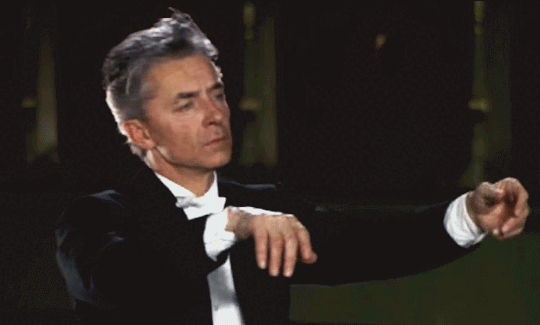
Those who have achieved all their aims probably set them too low.
- Herbert von Karajan
The Soprano Christa Ludwig described him as ‘Le bon Dieu’, while scores of musicians, reviewers and listeners have long regarded him as simply untouchable in the art of conducting. There was, however, much about Herbert von Karajan that was distinctly ungodlike. Ruthlessly ambitious as a young man and grimly autocratic in his later years, his life story is marked by bitter rivalries, feuds and, most notoriously, membership of the Nazi party.
But then, just listen to the results. It’s fascinating to look at the career, the controversy and the achievements of a conductor who still intrigues fans and detractors like no other musician long after his death.
The early career of Herbert von Karajan continues to be swathed in controversy.
Was he an ardent Nazi or an ambitious opportunist? If he was a zealous party member, should we revere his recordings as much as we do? To what extent should any moral accountability weigh against Karajan’s musical achievement? And how much latitude can we extend to people who have artistically given so generously?
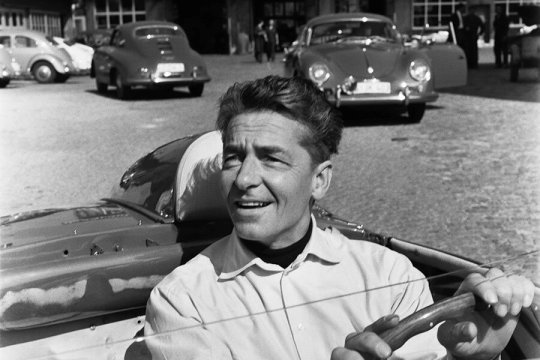
Karajan is not alone in occupying this uncomfortable situation during this era. Similar debate surrounds Richard Strauss, Carl Orff and Karl Böhm. Indeed, Wagner also evokes hostility in certain quarters with regard to his racial sentiments.
When Adolf Hitler swept to power in January 1933, the 24-year-old Austrian Herbert von Karajan had already notched up nearly four seasons as an up-and-coming opera conductor in the South German city of Ulm.
Born in Salzburg in 1908 into a prosperous family, he had demonstrated gifts as a pianist and conductor while studying in Vienna. After graduation, his debut orchestral concert with the Salzburg Mozarteum Orchestra in January 1929, featuring works by R Strauss, Mozart and Tchaikovsky, caused a local sensation and helped to secure him the contract in Ulm.
Karajan seized on the opportunity to learn his trade in Ulm and cut his teeth on much of the operatic repertory from Mozart and Beethoven to Puccini and R . Strauss, including the opera Schwanda der Dudelsacker by the Czech Jewish composer Jaromir Weinberger.
Yet, after the Nazi take-over, Karajan’s future wasn’t assured.
In early 1933, German operatic life was thrown into turmoil as the regime hounded out musicians that were deemed politically and racially unacceptable, and also pursued a protectionist policy to limit employment for non-Germans.
Against this context, Karajan’s decision to join the Nazi Party in Salzburg in April 1933 should be understood as an opportunistic move which was probably designed to safeguard his position at Ulm. Whether it also signalled enthusiasm for Nazi policy is open to speculation, though he no doubt hoped that the strong-arm methods of the Nazis would bring cultural stability to Germany.
Karajan retained his Ulm job for a further season, during which he expanded his repertory to include a praised account of Strauss’s opera Arabella. But in March 1934 he was fired for professional intrigue involving a potential Jewish rival.
He did not have to wait long for a new post. Three months later he was made general music director in Aachen.
Working in a larger theatre enabled Karajan to tackle more ambitious repertory, such as Wagner’s Ring cycle, Verdi’s Otello and Strauss’s Elektra. He also consolidated his reputation in the concert hall, taking charge of Aachen’s annual season of orchestral and choral concerts. One pre-condition for accepting was that he should re-apply for membership of the Nazi Party, his earlier membership in Salzburg having lapsed. This was confirmed in March 1935.

Although in his denazification trial in March 1946 Karajan argued that he had joined the Party to further his career, he could not escape his obligation as Aachen’s general music director to provide the musical background for political occasions.
On 29 June 1935 he took part in a huge open-air orchestral and choral concert that celebrated the NSDAP Party Day and at a similar ceremony four years later he conducted the close from Wagner’s Meistersinger. But his concert programmes seemed untainted by political interference – works by Debussy, Ravel, Kodály and Stravinsky rubbed shoulders with German ones. In 1938 he flouted the law by programming Dukas’s Sorcerer’s Apprentice. Party authorities must have overlooked that Dukas was of Jewish descent.
Karajan conducts Dvořák’s “New World” Symphony No. 9, performed by the Vienna Philharmonic Orchestra
By 1937 Karajan’s achievements in Aachen were attracting national interest.
In a special edition devoted to Germany’s conducting legacy, the journal Die Musik singled him out as a man who ‘can lead the new organisation of our cultural life in the spirit and direction which National Socialism demands’. Concert engagements in Gothenburg, Vienna, Amsterdam, Brussels and Stockholm helped to spread his name beyond Germany.
Yet for all this, Karajan set his sights even higher by hoping to make an impact in Berlin. This ambition was realised in 1938 with a ‘Strength through Joy’ concert with the Berlin Philharmonic and engagement as conductor at the Berlin State Opera in Wagner’s Tristan und Isolde in October of the same year.
Karajan may not have anticipated that with his move to Berlin he was stepping into a political cauldron over which he would have little control.
It began with a review of his Tristan which appeared in the Berliner Zeitung. Under the title ‘Karajan the Miracle’, the critic Edwin von der Nüll lavished praise on the performance suggesting that in conducting Wagner’s score from memory the 30-year-old conductor had achieved ‘something our great men in their fifties might envy’.
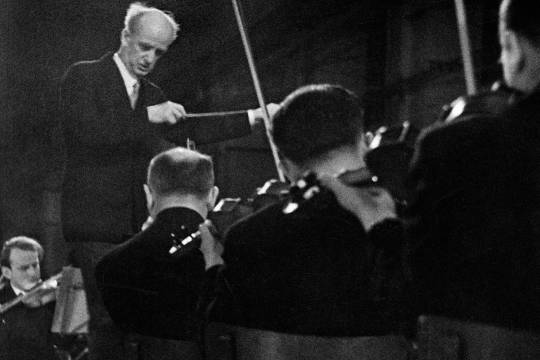
This was calculated to offend the conductor Wilhelm Furtwängler who had previously ruled the roost in the same theatre. Karajan was set up as a pawn in the struggle for control of Berlin’s cultural institutions between Propaganda Minister Joseph Goebbels, a Furtwängler supporter, and Minister of Interior Hermann Goering, the patron of the Berlin State Opera.
In June 1939 Karajan conducted Wagner’s Die Meistersinger at the State Opera without a score. The performance collapsed when the baritone, a drunk Rudolf Bockelmann, made a serious error. Alas Hitler, in the audience, was furious, blaming instead Karajan’s insufficiently Germanic approach to Wagner by conducting from memory.
Further problems arose over his marriage in 1942 to the quarter Jewish Anita Gütermann, technically against the law.
Yet, despite this and the continuing hostility and suspicion of Goebbels and Hitler and Furtwängler’s jealousy, his career prospered during the war. He conducted Bach’s B Minor Mass in Paris for the occupying German soldiers in 1940 and returned to the French capital in 1941 to present his performance of Tristan with the Berlin State Opera.
From 1940 he appeared in Italy and gave concerts in Romania and Hungary. A major achievement was to secure popularity for Orff’s Carmina Burana, a score that had aroused some hostility from the Nazi hierarchy at its first performance in 1937 before Karajan’s performances in Aachen and Berlin during the early 1940s.

Driven by a fanatical love of music and a desire to advance his career, there’s little doubt that Karajan’s involvement with the Nazi regime was opportunistic.
Doubtless though there were also areas of Nazi policy that may well have chimed in with his own views. At the same time falling foul of the regime on occasions, his personal ideology can be best described as a montage of greys; nothing is ever clear-cut and nor perhaps should be our assessment of his work.
#karajan#herbert von karajan#quote#conductor#music#german#nazi germany#nazism#opera#orchestra#classical music#history#arts#culture
36 notes
·
View notes
Text
Was doing some research (as the buzz wears off) on Saturn going into Pisces. Neptune is already in Pisces - “heavy fog and water” is my first thought.
But the weird part is that the two will not be exactly conjunct until February 20, 2026 - at 0°43’ Aries. A very long build-up that has a surprise plot twist at the end.
Anyway, the last time both Saturn and Neptune were together in Pisces was intermittently between 1847-9. My friend Wikipedia provided me with some events which struck me as typical:
May 1847 - Architectural Association School of Architecture founded in London
May 7, 1847 - American Medical Association founded in Philadelphia
June 1, 1847 - first congress of the Communist League, London
February 21, 1848 - publication of The Communist Manifesto, London
February 1848 and onward - revolutions in France, Hungary, Germany, and elsewhere in Europe
March 18, 1848 - Boston Public Library opens
March 29, 1848 - Queen’s College, London, first to award academic qualifications to women
July 1848 - Public Health Act, England and Wales, begins to address sanitation issues
July 19, 1848 - first Women’s Convention in Seneca Falls, NY; introduction of “bloomers”
August 19, 1848 - first newspaper articles in eastern US about the California gold rush
January 23, 1849 - Elizabeth Blackwell becomes the first woman MD in the US
Looking up those years in art and music was disappointing, as there was a decided lack of definite dates. Grrr. But I found three representative things for 1848:
April 1 - disgusting POS of a human, composer Richard Wagner, first wrote down his intention to write what would eventually become his “Ring” cycle of four operas. Talk about a blend of inspiration (Neptune) and discipline (Saturn).
September 1848 - the pre-Raphaelite Brotherhood of artists, poets, and critics is founded in London.
And best of all, to me anyway: sometime before October 1848, Joseph Bracket wrote the song “Simple Gifts:”
'Tis the gift to be simple, ’tis the gift to be free
'Tis the gift to come down where we ought to be,
And when we find ourselves in the place just right,
'Twill be in the valley of love and delight.
When true simplicity is gained,
To bow and to bend we shan’t be ashamed,
To turn, turn will be our delight,
Till by turning, turning we come ’round right.
Makes me feel better about what’s to come, to think about those words - set, of course, to Aaron Copland’s wonderful music.
14 notes
·
View notes
Video
youtube
Stephen Fry Addresses The Nation | Channel 4 Alternative Christmas Message
I don’t normally bother with this ‘Alternative Christmas Message’. The Queen, or now The King’s Speech has always been enough for me. Quaint, old fashioned thing that I am.
But this is Stephen Fry. And I’d happily listen to him read The Telephone Directory, with his ‘...vocal cords made of tweed.’
I’m delighted to hear him out here as well. I already know he’s Jewish as much as I know he’s gay.
I recall him mentioning that his mother’s family have Ashkenazi heritage. I think it was when he was talking about Wagner’s Ring Cycle. And, if I’ve heard this correctly. Jewish blood on the maternal side makes one a Jew too.
It hasn’t surprised me to hear antisemitism from The Far Left, because it’s been so prevalent from The Far Right, and the two are both sides of the same bad penny. It was only a matter of the opportune moment for the hate to show itself. *
We can mourn and criticise the appalling death toll brought about by Israel’s response to the Oct 7th Massacre by Hamas. In fact, we should.
In war, civilian casualties should be avoided as much as humanly possible. But, they do still happen, and we shouldn’t accept them as ‘just one of those things’. People are losing their lives, and Life is Sacred.
At the same time, what Hamas did on Oct 7th was terrorism, it was murder, it was brutal. Worse still, they took pleasure and pride in the act. There’s video evidence of it.
And they make no secret of their desire to kill Jews. Israel had every right to respond to such evil. Nothing on this earth justified it.
Palestinians should get their own land, a secure and safe place to call home. Yes, yes, yes.
But. Jews should also get to call The Land of Israel their home too. It stretches back in the history of their People. The Land of Judea is filled with historical evidence of being the Jewish home. It was taken from them, they didn’t merely leave it behind.
And I’ve heard Jews say at Pesach (aka Passover) ‘Next Year In Jerusalem.’
Generations of Palestinians have lived in parts of the country, and yes. I say they should be able to keep doing so. That’s fair enough.
But is it really so difficult for two sides to find a way to establish a Palestinian State and The Jewish State of Israel?
From what I’ve seen on maps. What’s called Israel is such a tiny areas, compared with The Middle East as a whole.
Yes. I’m naive. I don’t understand what’s going on. And it’ll be way too complex for me to have any chance of doing so.
But I can understand that Palestinians should have their own independent, secure home.
And Jews should be free to call Israel home, without being demonised for it.
* (Yes. I have the same non tolerance for anti Muslim hatred. I won’t say ‘Islamophobia’, because religions are sets of ideas, and any set of idea should be open to scrutiny and criticism when need be.
Hate against those who practice any faith, in this case Muslims = those who practice Islam. That’s another matter entirely. It’s never OK.
Yes. We can and should expect that anyone using their faith to spread hate is dealt with by the law. We have hate preachers infesting the UK’s mosques. That should not be allowed to continue.
But the many muslims who are our neighbours, our schoolmates, our work colleagues and our friends. They should be safe and secure to live their faith in the UK, because freedom of religion is important to us and should always be so.)
4 notes
·
View notes
Text
@ariel-seagull-wings sent me a message asking which operas I think the Muppets would like best.
So here are my headcanons: the favorite operas of some of the Muppets.
Kermit – I think he would like La Bohéme. It's a simple slice-of-life, not too melodramatic as opera go, it blends comedy and melancholy, and even though it ends sadly, it's still a heartwarming portrayal of a group of friends. He might also enjoy Musetta's diva antics: they would remind him of a certain pig.
Miss Piggy – Wagner's operas, especially the Ring Cycle. They're larger-than-life and full of passion and spectacle, they're great vehicles for prima donnas with big voices, and because of the vocal power they require, they tend to be vehicles for plus-sized divas too.
Gonzo – The Magic Flute. He would like the weirdness of it, and no lady in opera would be more beautiful to him than Papagena. She would remind him of Camilla.
Fozzie Bear – The Barber of Seville. The most famous of all comic operas.
Scooter – The Marriage of Figaro. Its intellectual depth and history as sociopolitical commentary would appeal to his nerdiness, and because he's the Muppet Theatre's "gofer," he'd enjoy an opera where the servants are the heroes.
His sister Skeeter – She would also like Figaro, but for a different reason: because of its proto-feminist themes, with strong-minded women banding together to teach a lesson to a powerful, badly-behaved man.
Rowlf – Fidelio, because he loves Beethoven. He even mentions it in passing in the song "Eight Little Notes." (Quartets, quintets, fugues and sonatas, plus an opera and a few cantatas...")
Sam the Eagle – Porgy and Bess, because it's the great American opera. At least that's what he would say; if he were really as cultured as he pretends to be and actually saw it, he would be appalled by the depiction of drugs and violence.
Rizzo the Rat – Don Giovanni. He would see a kindred spirit in Leporello: a sarcastic lovable coward who gets dragged unwillingly through crazy hijinks and occasionally steals other people's food.
Pepe the King Prawn – Carmen. It's Spanish (in setting, at least) and spicy, like he is.
Robin the Frog – Hansel and Gretel, because it's an opera for kids and about kids, where kids triumph over evil.
Animal – He would also like Hansel and Gretel: all that good food onstage! He'd probably charge up there and start eating the gingerbread house, and wouldn't even stop when he realized it wasn't real gingerbread.
Statler and Waldorf – They would make fun of it all, just like they do everything else.
18 notes
·
View notes
Text
Die Nibelungen (Fritz Lang, 1924)
Die Nibelungen: Siegfried
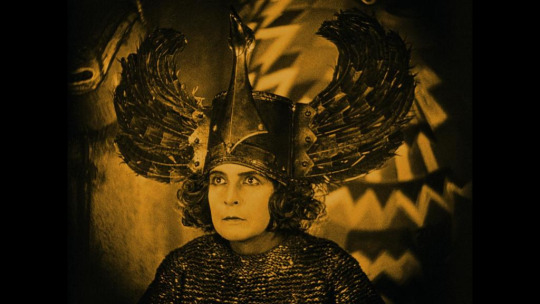
Hanna Ralph in Die Nibelungen: Siegfried
Cast: Gertrud Arnold, Margarete Schön,Hanna Ralph, Paul Richter, Theodor Loos, Hans Adalbert Schlettow Georg John.
Die Nibelungen: Kriemhild's Revenge
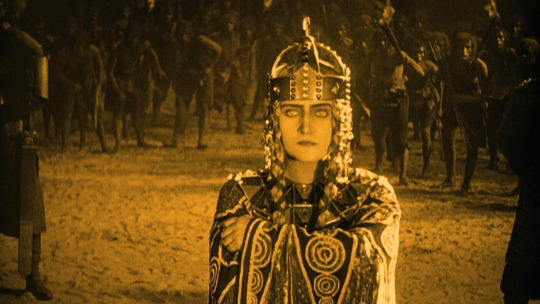
Margarete Schön in Die Nibelungen: Kriemhild's Revenge
Cast: Margarete Schön, Gertrud Arnold, Theodor Loos, Hans Adalbert Schlettow, Rudolf Klein-Rogge, Georg John.
Screenplay: Fritz Lang, Thea von Harbou. Cinematography: Carl Hoffmann, Günter Rittau, Walter Ruttmann. Art direction: Otto Hunte, Karl Vollbrecht. Costume design: Paul Gerd Guderian, Aenne Willkomm. Music: Gottfried Huppertz.
Fritz Lang's two-part epic, based on the Middle High German Nibelungenlied, will confuse anyone who knows the story only via Richard Wagner's Ring cycle: There are no Rhinemaidens or gods or Valkyries, nothing of Siegfried's parentage, and, since it lacks gods, consequently no Götterdämmerung. It consists of two films, Siegfried and Kriemhild's Revenge, that tell the story -- parts of which will be familiar from the final two operas in Wagner's cycle -- of how Siegfried slew the dragon and bathed in its blood, becoming invincible except for one spot on his back that the blood failed to touch, then killed the dwarf Alberich and took possession of a magic net that renders him invisible. He travels to Burgundy, where he wins the hand of the beautiful Kriemhild by helping her brother, King Gunther, subdue the warrior maiden Brunnhild. But Siegfried is killed after Gunther's advisor, Hagen, tricks Kriemhild into revealing his vulnerable spot. Brunnhild kills herself and Kriemhild vows revenge on the whole lot, which in the second film she accomplishes by marrying King Etzel, aka Attila, and provoking war between his Huns and the Burgundians. Lang tells the story with an eye-filling blend of tableaus, set-pieces, and scenes swarming with bloody action, concluding with a spectacular fire in which the Burgundians are trapped in Etzel's castle. The performances are pretty spectacular, too. Paul Richter plays Siegfried as a muscular young goof ensnared by fate, Hanna Ralph is a formidable Brunnhild, and Margarete Schön modulates from naïve to terrifying as Kriemhild. But it's the production design by Otto Hunte and the costuming by Paul Gerd Guderian that lingers most in the memory. The production evokes late 19th- and early 20th-century book illustrators like Arthur Rackham and Walter Crane, but also the stark hieratic figures of Byzantine mosaics, especially Kriemhild, who becomes more powerfully static as the film progresses. Much has been written about the way the film fed into the heroic German myth that was co-opted by the Nazis, especially since the screenwriter, Thea von Harbou, Lang's wife at the time, later joined the party. (Lang, whose mother was Jewish, left Germany in 1934.) In fact, the Nazis sanctioned only the first half, Siegfried, after they came to power. Kriemhild's Revenge, with its depiction of the corruption of power and its nihilistic ending, didn't suit their purposes.
7 notes
·
View notes
Text
Die Nibelungen (Fritz Lang, 1924)
Die Nibelungen: Siegfried
Cast: Gertrud Arnold, Margarete Schön, Hanna Ralph, Paul Richter, Theodor Loos, Hans Adalbert Schlettow, Georg John.
Die Nibelungen: Kriemhild's Revenge
Cast: Margarete Schön, Gertrud Arnold, Theodor Loos, Hans Adalbert Schlettow, Rudolf Klein-Rogge, Georg John.
Screenplay: Fritz Lang, Thea von Harbou. Cinematography: Carl Hoffmann, Günter Rittau, Walter Ruttmann. Art direction: Otto Hunte, Karl Vollbrecht. Costume design: Paul Gerd Guderian, Aenne Willkomm. Music: Gottfried Huppertz
Fritz Lang's two-part epic, based on the Middle High German Nibelungenlied, will confuse anyone who knows the story only via Richard Wagner's Ring cycle: There are no Rhinemaidens or gods or Valkyries, nothing of Siegfried's parentage, and, since it lacks gods, consequently no Götterdämmerung. It consists of two films, Siegfried and Kriemhild's Revenge, that tell the story -- parts of which will be familiar from the final two operas in Wagner's cycle -- of how Siegfried (Paul Richter) slew the dragon and bathed in its blood, becoming invincible except for one spot on his back that the blood failed to touch, then killed the dwarf Alberich (George John) and took possession of a magic net that renders him invisible. He travels to Burgundy, where he wins the hand of the beautiful Kriemhild (Margarete Schön) by helping her brother, King Gunther (Theodor Loos), subdue the warrior maiden Brunnhild (Hanna Ralph). But Siegfried is killed after Gunther's advisor, Hagen (Hans Adalbert Schlettow), tricks Kriemhild into revealing his vulnerable spot. Brunnhild kills herself and Kriemhild vows revenge on the whole lot, which in the second film she accomplishes by marrying King Etzel (Rudolf Klein-Rogge), aka Attila, and provoking war between his Huns and the Burgundians. Lang tells the story with an eye-filling blend of tableaus, set-pieces, and scenes swarming with bloody action, concluding with a spectacular fire in which the Burgundians are trapped in Etzel's castle. The performances are pretty spectacular, too. Richter plays Siegfried as a muscular young goof ensnared by fate, Ralph is a formidable Brunnhild, and Schön modulates from naïve to terrifying as Kriemhild. But it's the production design by Otto Hunte and the costuming by Paul Gerd Guderian that lingers most in the memory. The production evokes late 19th- and early 20th-century book illustrators like Arthur Rackham and Walter Crane, but also the stark hieratic figures of Byzantine mosaics, especially Kriemhild, who becomes more powerfully static as the film progresses. Much has been written about the way the film fed into the heroic German myth that was co-opted by the Nazis, especially since the screenwriter, Thea von Harbou, Lang's wife at the time, later joined the party. (Lang, whose mother was Jewish, left Germany in 1934.) In fact, the Nazis sanctioned only the first half, Siegfried, after they came to power. Kriemhild's Revenge, with its depiction of the corruption of power and its nihilistic ending, didn't suit their purposes.
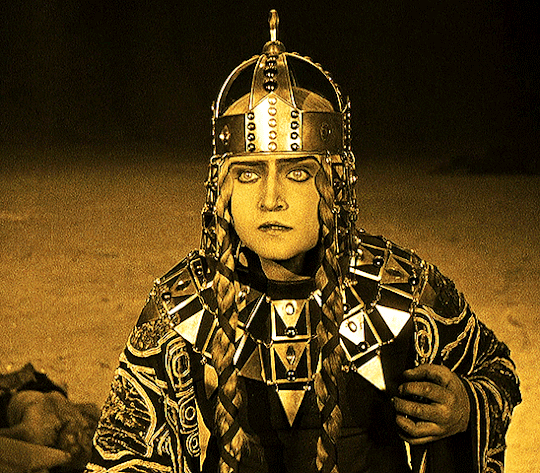
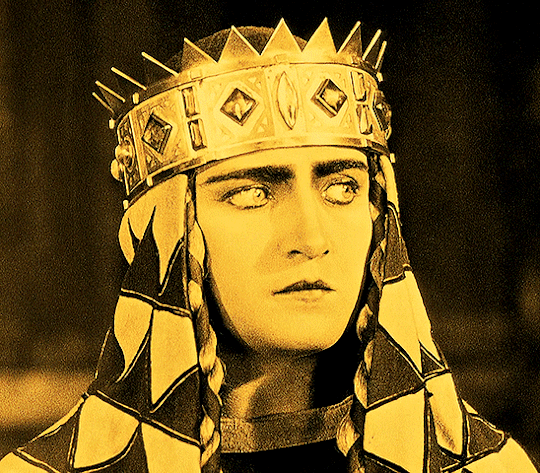

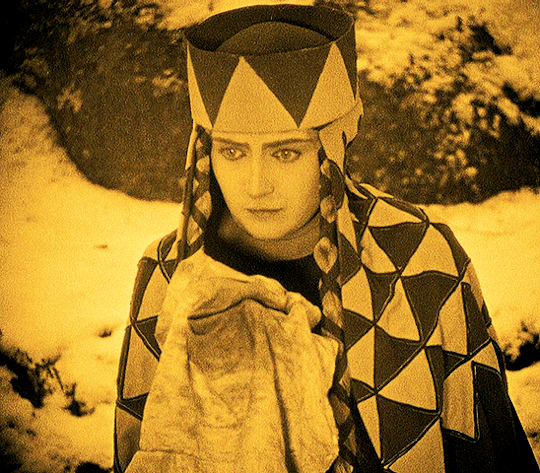
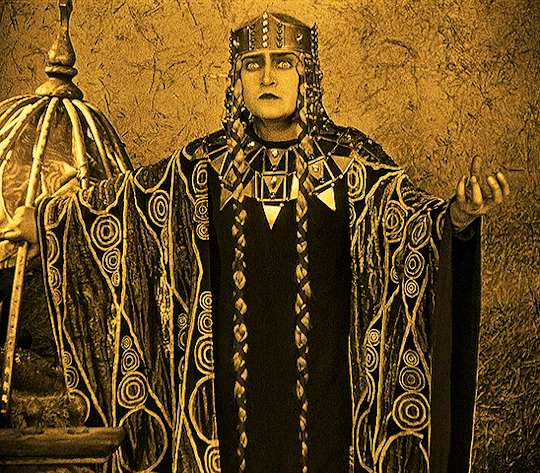
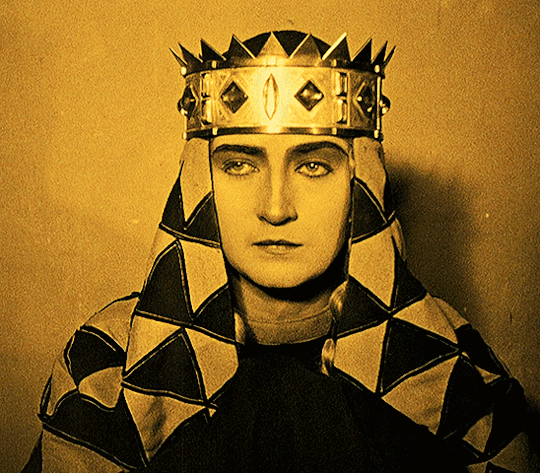
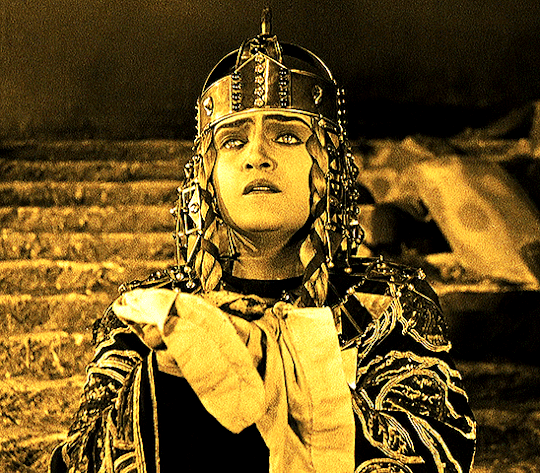

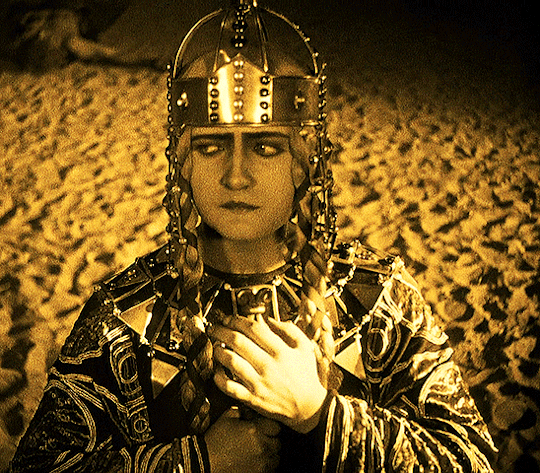
Margarete Schön as Kriemhild of Burgund
DIE NIBELUNGEN: KRIEMHILD'S REVENGE (1924) | dir. Fritz Lang
2K notes
·
View notes
Text
Das Rheingold, Meditations on Wagner's Vorabende
To begin this journal, let us briefly discuss the history and impact of Richard Wagner. Richard Wagner—love him or hate him—is practically unavoidable in music history because of his revolutionary work. His influence on music history is profound; among other achievements, he may have single-handedly challenged the tonal system (or at least tried to), incorporating so many chords and notes from outside the expected major and minor keys that audiences must rely on his leitmotifs for orientation. From a compositional point of view, Wagner left future composers unsure of what boundaries remained to be pushed. He expanded the size of the orchestra and the demands placed on singers to the very limit of human capability. Indeed, it is simply a statement of fact that only some opera singers possess the physical stamina and vocal power to perform as Wagner’s music requires. These extraordinary demands become most evident in the music he composed for the Ring cycle.
The core orchestration for the Ring cycle includes one piccolo, three flutes, three oboes, one cor anglais, three soprano clarinets, one bass clarinet, three bassoons, eight horns, three trumpets, one bass trumpet, three tenor trombones, one contrabass trombone, one contrabass tuba, and a four-timpani percussion section with triangle, cymbals, tam-tam, six harps, 16 first violins, 16 second violins, 12 violas, 12 cellos, and eight double basses. Wagner wrote Das Rheingold (the first evening of the cycle, or “Vorabend”) with a greatly enlarged orchestra, even adding an offstage harp and 18 offstage anvils.
Wagner is the composer from whom all modern soundtracks arguably descend. He “invented” the systematic use of leitmotifs—he called them “guides to feeling”—and viewed them as analogous to the ancient Greek chorus, offering emotional commentary to the action on stage. Through these leitmotifs, the audience understands the emotional development of the scene nonverbally, grasping subtle shifts in emotion, character, and action. These leitmotifs, centered on recurring patterns, themes, and harmonic progressions, represent actions, objects, emotions, characters, and other dramatic subjects. Wagner’s liberal use of chromatically altered chords may well have inspired Arnold Schoenberg’s revolutionary move toward atonality.
Wagner was influenced by the philosopher Friedrich Nietzsche, who, in turn, affected Wagner’s views on history, myth, and German nationalism. Wagner’s obsession with Germanic myth finds its fullest voice in the Ring cycle. Das Rheingold, the prelude to the cycle, opens in the depths of the Rhine river. The first three characters are the three Rhine maidens, charged with guarding the precious gold in the Rhine. Essentially, Wagner begins his “Vorabend” in a German river, with German guardians protecting a German treasure. The thematic purpose of the Ring cycle is to establish a German-centric mythos, and the opening of Das Rheingold thrusts that message directly at the audience.
Das Rheingold opens an epic cycle drawn from legendary sagas found in the Nibelungenlied. Wagner referred to the Ring as a “Bühnenfestspiel” (stage festival play), and it unfolds over three days and a preliminary evening to encompass the full dramatic journey. Spanning four performances and about 15 hours, Wagner’s story imitates the structure of Greek drama—three tragedies and one satyr play—but he freed it from traditional operatic structures like arias and choral numbers. In Das Rheingold, no chorus exists; its role is taken by the leitmotifs. This opera holds a special place in the cycle, as it sets the stage for the gods’ dramatic struggles that follow.
Several prominent themes appear in Das Rheingold. Nature in its entirety is represented by the Rhine. Alberich, the loathsome dwarf, symbolizes a base, unrestrained form of desire. The gods, too, are morally compromised, particularly Wotan, who trades away his daughter’s freedom. Wotan, the one meant to establish order, seeks to build a “heaven” but must do so through deals that bring “hell.” Wagner’s world is not a pleasant one. The heroes must struggle mightily, and their own desires are questionable as they vie to obtain the ring.
Leitmotifs address three key tensions Wagner faced as he strove to create his own form of opera. They provide a method of unifying verse with melody; they form a natural alternative structural element to the disconnectedness that arias would otherwise introduce; and they provide an organic means of organizing the opera’s development and modulation. Additionally, leitmotifs serve as musical cues linking emotions, actions, and concepts without requiring the audience to consciously articulate them. Thus, leitmotifs unify the work while allowing for free variation.
As I watched Das Rheingold, I noted several motifs. There seems to be a “genesis” or “nature” motif that opens the opera, set at a slow tempo, symbolizing the beginning of the world. Bassoons and trumpets introduce this idea. There is a gold/treasure motif that initially descends before it ascends, sounding dark and tense; the trumpets and violins combine to convey this stress and importance. The Rhinemaidens’ pleasure in the gold is represented by a separate motif, played by the strings, which is lighthearted and carefree. Contrastingly, the motif associated with the gold’s magical power, contingent upon renouncing love, is dark, descending, and instrumented by cellos and basses—fitting, since a world without love is indeed dark.
I greatly enjoyed Das Rheingold. I found Wagner’s attempt to create a complete German mythos reminiscent of J.R.R. Tolkien’s effort to fashion a British mythology in The Lord of the Rings. Both revolve around a ring cursed to doom its bearer, involve a heroic journey to obtain or destroy it, and feature a pantheon of supernatural beings inhabiting a dramatic, epic space where spiritual and material realms collide. Yet Tolkien’s story offers hope—a light at the end of the tunnel—making it ultimately more uplifting. Wagner’s world, by contrast, is one of relentless struggle and futility. I would watch Das Rheingold, and indeed the entire Ring cycle, only through a lens that acknowledges eternal truth and rejects the hopelessness Wagner’s narrative seems to suggest.
0 notes
Text
Events 8.16 (before 1920)
1 BC – Wang Mang consolidates his power in China and is declared marshal of state. Emperor Ai of Han, who died the previous day, had no heirs. 942 – Start of the four-day Battle of al-Mada'in, between the Hamdanids of Mosul and the Baridis of Basra over control of the Abbasid capital, Baghdad. 963 – Nikephoros II Phokas is crowned emperor of the Byzantine Empire. 1328 – The House of Gonzaga seizes power in the Duchy of Mantua, and will rule until 1708. 1513 – Battle of the Spurs (Battle of Guinegate): King Henry VIII of England and his Imperial allies defeat French Forces who are then forced to retreat. 1570 – The Principality of Transylvania is established after John II Zápolya renounces his claim as King of Hungary in the Treaty of Speyer. 1652 – Battle of Plymouth: Inconclusive naval action between the fleets of Michiel de Ruyter and George Ayscue in the First Anglo-Dutch War. 1777 – American Revolutionary War: The Americans led by General John Stark rout British and Brunswick troops under Friedrich Baum at the Battle of Bennington in Walloomsac, New York. 1780 – American Revolutionary War: Battle of Camden: The British defeat the Americans near Camden, South Carolina. 1792 – Maximilien de Robespierre presents the petition of the Commune of Paris to the Legislative Assembly, which demanded the formation of a revolutionary tribunal. 1793 – French Revolution: A levée en masse is decreed by the National Convention. 1812 – War of 1812: American General William Hull surrenders Fort Detroit without a fight to the British Army. 1819 – Peterloo Massacre: Seventeen people die and over 600 are injured in cavalry charges at a public meeting at St. Peter's Field, Manchester, England. 1841 – U.S. President John Tyler vetoes a bill which called for the re-establishment of the Second Bank of the United States. Enraged Whig Party members riot outside the White House in the most violent demonstration on White House grounds in U.S. history. 1844 – Governor-general of the Philippines Narciso Claveria, signs a decree to reform the country's calendar by skipping Tuesday, December 31, as a solution to anomalies that had existed since 1844. 1858 – U.S. President James Buchanan inaugurates the new transatlantic telegraph cable by exchanging greetings with Queen Victoria of the United Kingdom. However, a weak signal forces a shutdown of the service in a few weeks. 1859 – The Grand Duchy of Tuscany formally deposes the exiled House of Lorraine. 1863 – The Dominican Restoration War begins when Gregorio Luperón raises the Dominican flag in Santo Domingo after Spain had recolonized the country. 1869 – Battle of Acosta Ñu: A Paraguayan battalion largely made up of children is massacred by the Brazilian Army during the Paraguayan War. 1870 – Franco-Prussian War: The Battle of Mars-la-Tour is fought, resulting in a Prussian victory. 1876 – Richard Wagner's Siegfried, the penultimate opera in his Ring cycle, is premiered at the Bayreuth Festspielhaus. 1891 – The Basilica of San Sebastian, Manila, the first all-steel church in Asia, is officially inaugurated and blessed. 1896 – Skookum Jim Mason, George Carmack and Dawson Charlie discover gold in a tributary of the Klondike River in Canada, setting off the Klondike Gold Rush. 1900 – The Battle of Elands River during the Second Boer War ends after a 13-day siege is lifted by the British. The battle had begun when a force of between 2,000 and 3,000 Boers had surrounded a force of 500 Australians, Rhodesians, Canadians and British soldiers at a supply dump at Brakfontein Drift. 1906 – The 8.2 Mw Valparaíso earthquake hits central Chile, killing 3,882 people. 1913 – Tōhoku Imperial University of Japan (modern day Tohoku University) becomes the first university in Japan to admit female students. 1913 – Completion of the Royal Navy battlecruiser HMS Queen Mary. 1916 – The Migratory Bird Treaty between Canada and the United States is signed. 1918 – The Battle of Lake Baikal was fought between the Czechoslovak Legion and the Red Army.
0 notes
Text
Leitmotifs in the Mass Effect trilogy
BioWare's Mass Effect trilogy is a well-loved, action packed RPG set in a future where an ancient technology has allowed humans and many other alien species to colonise galaxies far from their own. The different species live in almost-harmony, with a new inter-race Council overseeing relations.
The protagonist and player character, Commander Shepard, is a human in the Alliance (Earth) Military who becomes responsible for preventing a long-forgotten race of beings called Reapers from wiping out all intelligent life in the galaxy. Throughout their mission, Shepard meets a number of companions who choose to join them, making up a strong and interesting squad from many different backgrounds and races.
Throughout the trilogy, Shepard and their party suffer losses, betrayals, and twists and turns as they strive to save the galaxy, the fate of which is very much in the player's hands.
The Use of Music as Signs
Music is used frequently in media to convey certain moods or invoke specific feelings. Recurring themes within a piece of music or across multiple pieces can be used effectively in this way, causing the audience to subconsciously relate what's happening to other times the music has been used, further influencing the mood being conveyed.
Although many composers used recurring themes in their music before this, Richard Wagner is the composer most associated with the use of such recurring themes, called leitmotifs (Smith, 2021). His use of recurring themes, most famously in his set of operas, Ring Cycle, allowed the audience to identify characters, locations, and themes through the music that accompanied them.
Leitmotifs and musical themes can be considered a form of semiotics. The principle of music as a "sign", as it is termed in the theory of semiotics, is that all music carries meaning that we can associate with specific features of a piece (Tarasti, 2018).
Whilst Ferdinand de Saussure and Charles Sanders Peirce both propose similar but differing models of semiotics, neither discus the use of music in semiotics. Saussure's work referenced a signifier, which is the form the sign takes, and a signified, the concept represented by the sign (Chandler, D. 2019). Peirce's model discussed the use of a signifier and an interpretant, which act as the signifier and signified do in Saussure's therory, with also a third element known as the object, which is the intended outcome that occurs upon someone perceiving the sign (Albert, A. 2023).
Within music, Descartes (1987) discusses the way in which tempo can influence the emotions conjured by listening to a piece of music. This is an example of semiotics within music. The signifier here is the tempo, with the signified/interpretant being the excitement or anticipation we feel with a fast-paced song, for example. Following Peirce's theory, the object would be the intent to create such a feeling in the audience.
In the context of leitmotif, the musical themes are the signifier - the object we create an association with. The feelings or mood that is created upon hearing that theme is the signified - the result of the association of the music with a particular event, character, or place.
Leitmotifs in Mass Effect
Many aspects of music can be interpreted as signs and can coney meaning, from the tempo to the instruments used, and even the melodies and motifs themselves, especially when they occur multiple times across different tracks.
The soundtrack to the Mass Effect trilogy features many recurring themes or motifs throughout, sometime spanning all 3 games. There are several excellent examples of this, with one of the most obvious examples being the use of Saren's theme (the main villain from Mass Effect 1) as the death screen music throughout Mass Effect 1, reinforcing the fact that if you lose the game you are losing to Saren, making the player hate him that bit more by the time the final boss fight comes around. Another use of a villains motif occurs in Mass Effect 3 in a track called Leaving Earth. This music plays when Shepard is forced to abandon Earth during an attack by the Reapers. Throughout the game and during the song the Reapers have a signature sound that plays to indicate they are present, a deep grinding noise that serves to instill panic and fear in the player.
One motif used throughout the trilogy is the Spectre Induction theme and leitmotif. The leitmotif is an uplifting and bold melody with a strong rolling drum beat to accompany it. The melody feels heroic and hopeful the moments it accompanies further instill that feeling of pride that the music invokes.
This piece of music first plays in Mass Effect 1 during a pivotal moment in the plot. Shepard is granted the status of Spectre, granting them full freedom to investigate and put a stop to the imminent Reaper invasion, without being tied down by the Council or the Alliance Military. This moment is one of immense pride for Shepard and their superiors - and the whole human race, really - as this marks the induction of the first ever human Spectre. The music strongly reflects this and, accompanied by the atmosphere created by the visuals in the scene it forms an incredible starting point to the rest of the game.
The same motif plays a couple of times in Mass Effect 2. In the beginning of ME2, Shepard is killed when their ship, the Normandy, is attacked and destroyed. Shepard's body is recovered and revived by a shady organisation known as Cerberus, who also rebuild a version of the Normandy for Shepard and their crew. The moment in which Shepard sees their new Normandy and sets of to continue their mission features another rousing piece of music, The Normandy Reborn, which contains a motif from Spectre Induction. Whilst the leitmotif conjures the same feelings of heroism and pride, this time it also signifies a new beginning for Shepard, as did their induction into the Spectres. Both times when this leitmotif played Shepard was on the cusp of a new start, about to embark on an adventure into the unknown. The accompanying feeling to The Normandy Reborn is one of hope and wonder, perfectly encapsulating the feeling the player gets upon seeing such a central part of the trilogy once again.
Near the end of ME2, Shepard and their crew undertake what is dubbed a "Suicide Mission" in an attempt to stop the Reapers and a group of indoctrinated beings known as the Collectors. After infiltrating the base, the player must now escape back to the Normandy before its destruction. As the player and their companions race back to safety, fighting off Collectors and falling debris, The End Run plays. There is a sense of desperation and intensity within this theme, with the leitmotif from before occurring once Shepard is on the ship and they are safely away from the destruction. There is a choral element to the music this time though, further adding to the sense of urgency felt by Shepard and the player. This moment is essentially the climax of the game, with everything having led up to this point so far. The use of the leitmotif shows the significance of this moment, with Shepard, once again, saving the day.
This leitmotif is used once more in Mass Effect 3 near the end of the game. Towards the finale, all of the decisions made throughout the trilogy culminate into an epic battle for Earth as the Reapers take over. The fleets of every race in the galaxy gather around Earth, led by the Normandy into an epic battle. As we begin to see the fleets arriving, the epic motif from Spectre Induction plays during The Fleets Arrive. The moment is jaw-dropping seeing the sheer scale of the aid that has arrived for Earth and the music reflects that. With Shepard and crew leading the charge, the heroic feeling that is present throughout the game returns in full force, and the realisation of how important these final moments are for everyone in the galaxy.
The overall feelings conjured by the motif are uplifting and heroic, with each use coming a time when there is a crucial chance to either put things right or fail miserably. It creates a feeling of wonder and also apprehension, as what lies ahead is unknown to both Shepard and the player.
To conclude
Music can effectively be used as other forms of semiotics can in video games to conjure specific feelings or portray a certain mood for the audience. The use of leitmotifs captures significant moments throughout gameplay and allows the player to subconsciously relate those to new experiences during the game, carrying those same feelings forward to moments that intend to create similar emotions.
References
Albert, A. (2023). Peirce’s Theory of Signs. The Stanford Encyclopaedia of Philosophy (Spring 2023 Edition). Edward N. Zalta & Uri Nodelman (eds.). https://plato.stanford.edu/archives/spr2023/entries/peirce-semiotics/
Chandler, D. (2019). Semiotics for Beginners. Visual Memory. https://www.cs.princeton.edu/~chazelle/courses/BIB/semio2.htm (Accessed 23/11/2023)
Descartes, R. (1987). Abrégé de musique. Compendium musicae. Paris : Presses Universitaires de France.
Smith, C. (2021). What is a leitmotif? Classical Music. https://www.classical-music.com/articles/what-is-a-leitmotif. (Accessed 23/11/2023)
Tarasti, E. (2018). Musical Semiotics – a Discipline, its History and Theories, Past and Present. Recherches sémiotiques. https://doi.org/10.7202/1051395ar
0 notes
Text
Richard Wagner
Unlike many composers, Wagner was not a child prodigy in Music. He wasn't all that good at it, and struggled to play scales on the Piano. He was much more interested in writing plays and showed little interest in music until he realised the most successful dramas included music. Only then did he set out to learn music.
10 things you might not know about Richard Wagner:
0 notes
Text
Despot Playbook.
It is very popular today. With so many despots in power around the world it makes Machiavelli look like a liberal. If you read him as if he were being sarcastic then he was.
But the current popular edition was written by Adolf Hitler not a renaissance Italian. First thing is to get elected. Exploit true popular support and win an honest election. Claim that you understand and can fix the serious problems the country has. You have a plan! Be sure to blame an easy to identify group as villains to focus hostility. Hostility wins elections.
Hitler blamed Jews and bolsheviks. Putin blamed Nazis and traitors. Trump blamed Latin American immigrants. Trump supporters blamed rich liberals who often were Jewish. You have to have a villain.
Once you are elected fix or just cancel subsequent elections. Hitler cancelled them. Putin fixed them and imprisoned or just killed opposition leaders. Trump set a mob loose to overturn his loss and almost did it. He tried hard to cancel the new election. Had congress submitted to his will he would be the "leader" for life. He still considers himself to be the leader of the GOP Party. The German word for leader is Fuehrer. There was just enough rule of law left in the US to divert that.
Putin has won his power and is very closely following the Hitler Playbook. His villains are NATO, the west, and anyone who opposes him. He was elected and fixed all subsequent elections. His strangest and scariest ploy is his personal army the Wagner Group. He seems to mistrust the Russian Army as they are the only group that could "take him out".
Hitler had the SS which was a military arm of his Nazi Party. It was his personal security as he did not trust the military either. Eventually they got tanks and fully equipped military divisions. They were not part of the formal German Military structure.
The Wagner Group is named after the Composer of the "Ring Cycle" about the mythos of Nordic superiority. Great music and Hitler's favorite composer. I suspect Putin likes him too. They have just obtained the newest top of the line Russian Tanks for their units. They do not officially exist yet can overturn prison sentences and murder with impunity.
Russia already has concentration camps with a high level of fatalities, but they have not got around to wholesale death camps....yet.
His war is to create a lasting legacy of empire. The Soviet Union was a Russian Empire. If he got Ukraine he would soon go after all the other bits that were lost when the S.U. collapsed.
Hitler's wars were the same thing. To create a lasting empire on the European Continent for Germans. His defeat came as he was opposed by an even more ruthless Despot, Joseph Stalin. Stalin built the Soviet Empire that Mr Putin so dearly misses.
Ambitions such as those are always opposed somehow. Ukraine is considered by many as the founding center of what is now called Russian Culture. It has existed as a independent nation for only a short time as it was at a cross roads of several empires. But for reasons I have gone over before they HATE Russians. Even had Russia won in a "4 day War" they would have been surrounded by a very hostile population.
So it is playing out.
Hitler's playbook is good for getting power, but has always failed to keep it. You cannot teach that to Despots. They are always right.
1 note
·
View note